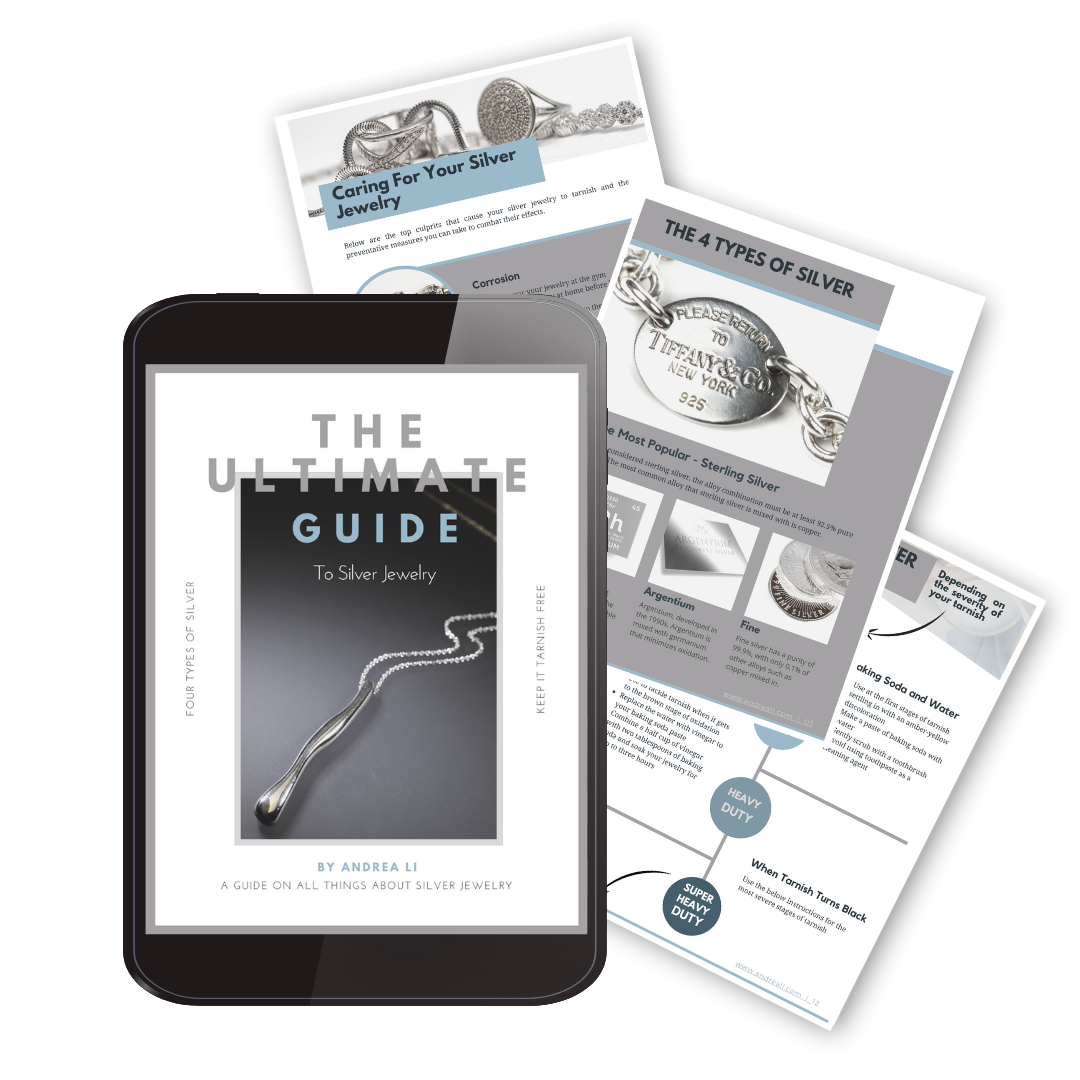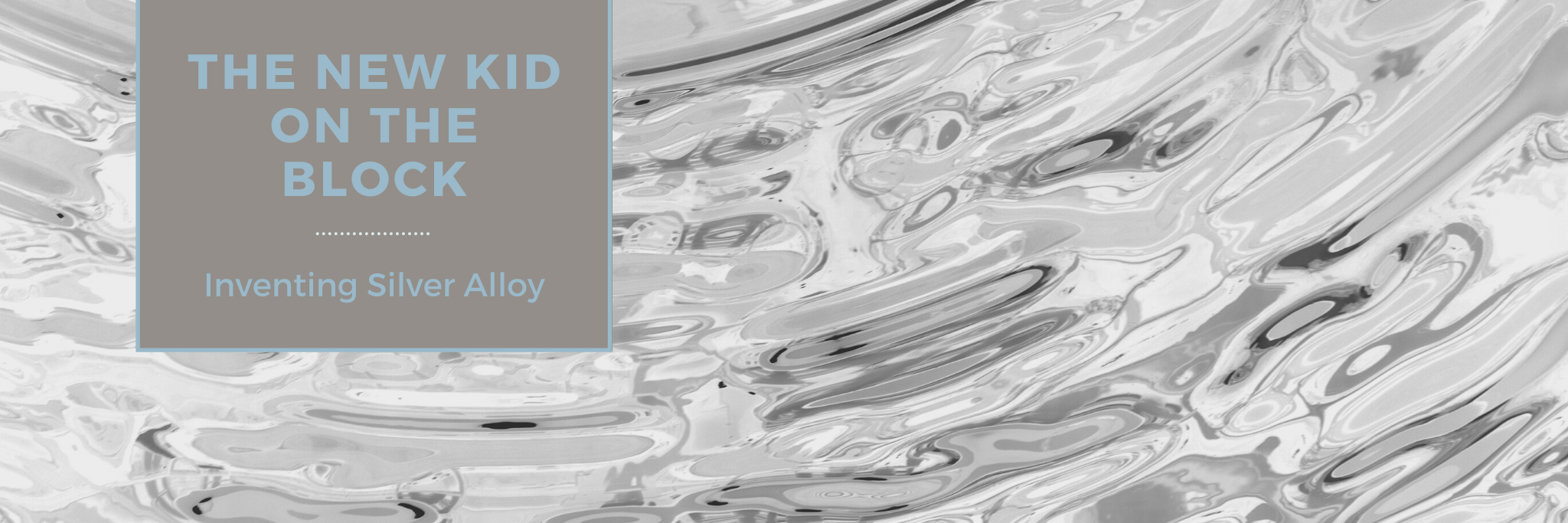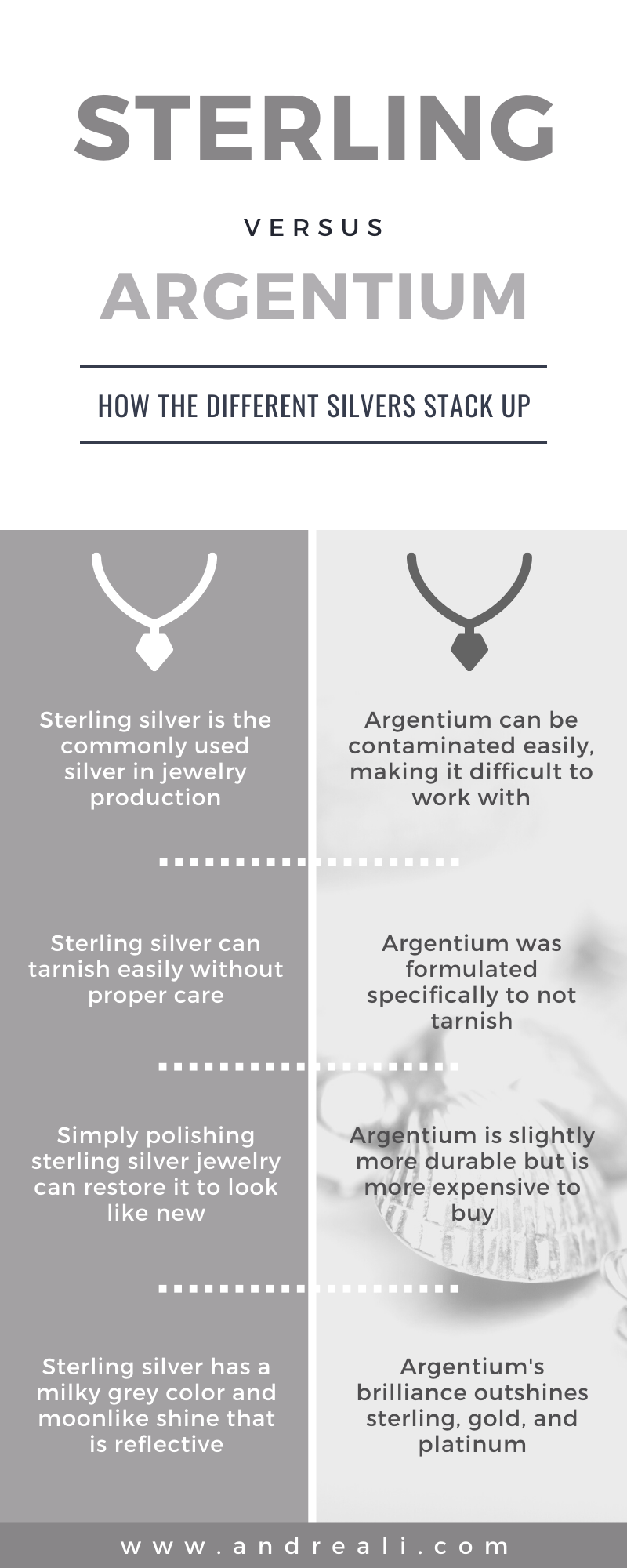The Four Different Types Of Silver Used In Jewelry
Whenever silver jewelry comes to mind, you’re probably thinking about sterling silver. You should because this is the most common of all the silvers used in jewelry today. You might be wondering, wait, there’s more than one type? You bet there is, and there’s not just one, two, or three, but four!
In this post, I will -
Explain the differences between all the various types of silver
Provide an understanding of which types are more valuable
Present to you the benefits of each one
Give you a bit of historical background on the different types
Specify the properties of each type
The Historical Background of Sterling Silver
It’s been recorded that silver in jewelry has been around since before 4000 BC, but the rise of popularity of sterling silver had not occurred until the 12th century.
The first legal definition in 1275, ‘Easterling Silver’, was aptly shortened to Sterling Silver, today’s familiar name. The first use of sterling silver was for coins to be traded at the cattle markets in Europe, not jewelry.
What is Sterling Silver?
So, what exactly is sterling silver? Great question. It’s a more useful version of pure silver, especially for the intended purpose of jewelry. Useful because pure silver is soft and malleable.
By creating an alloy mix with other metals, it becomes much more durable. To be considered sterling silver, the combination must be at least 92.5% pure silver.
What is Silver Mixed With?
The remainder can be any alloy, but the most common for jewelry usage is copper. The reason for this is that copper doesn’t affect silver’s beautiful color. The only drawback is that copper with silver can also cause a condition that afflicts many jewelers called fire scale.
This occurs when silver absorbs oxygen at high temperatures and conducts that oxygen to the metal’s interior, causing it to bond to the copper atoms. This is the result of overheating the silver during the production process. Take it from me - this side-effect can torment jewelers who regularly work with silver.
What Causes My Silver Jewelry to Tarnish?
Another common way copper can cause problems is with tarnishing. Anyone who owns a piece of sterling jewelry can attest to this issue.
This chemical reaction is accelerated by the presence of copper in the alloy mixture. The darkened discoloration of tarnish is primarily caused when the silver blend is exposed to sulfur-containing gases in the air.
Living near industrial areas with a greater volume of air pollution, using everyday products with sulfur compounds, or eating a diet rich in sulfur such as eggs can all advance tarnish’s effects.
The good news is that there are plenty of ways to prevent this from happening and easy solutions to fix it when it does. Get the full details here.
The Benefits of Sterling Silver Jewelry
Aside from the drawback of fire scale and tarnishing, sterling silver is a fine choice of alloy to use in jewelry. I mentioned before that it’s incredibly durable, but more than that, its shine when polished is quite stunning.
Its appearance has even been likened to that of the moon with its milky grey color and incredible brightness. Plus, it’s a precious metal that is more affordable than it’s other more precious counterparts, such as gold or platinum.
Additionally, the wide use of sterling silver gives you an extensive range of options for purchasing it. Endless choices are available from independent designers to mainstays of the jewelry industry.
Well-established design houses like Tiffany & Co continue to have sterling silver collections as a foundation to their fine jewelry lines. Even modern household name designers such as John Hardy and David Yurman built their jewelry empires exclusively with sterling silver collections.
The relevancy of sterling silver use in jewelry is here to stay due to the high demand and desirability among consumers. This means that it will hold its value for generations to come. It offers everyday luxury whose aesthetic will adapt to any trend that challenges its aptness to remain a significant part of human culture’s adornment.
What Silver Came Next?
In the beginning, there was silver, then along came sterling silver, but this produced a new issue of tarnishing.
This has become such a wide-spread and insidious problem that the following varieties of silver I cover in the rest of this post were all created to address this issue specifically.
The point of minimizing the effects of tarnishing of which I will share my findings on each.
Starting in chronological order, let’s start with rhodium plating on silver jewelry but first a little historical background.
The Historical Background of Rhodium Plating
Rhodium itself has a chrome appearance and is tough as nails. Ronson Lighter Company initially used it in commercial applications to produce art deco style cigarette lighters in the late 1930s.
Due to the virtually tarnish-proof rhodium properties, it was easy to expand its usage to silverware. The plating gave the silver a durably hard finish that required significantly less polishing and cleaning to combat the effects of tarnishing.
The obvious benefits of its usage caused commercial applications to expand rather rapidly in the 1950’s to jewelry. Now rhodium plating is used widely with silver and white gold jewelry to increase their lustrous appearance that is virtually free of any tarnishing effects.
What is Rhodium?
Believe it or not, rhodium is the most expensive metal on the planet: That’s right, folks, it’s more valuable than gold or platinum and far rarer. Talk about virtuous qualities of everything you could ask for in an alloy; some of the top characteristics are -
It’s hypoallergenic, so no weird skin rashes or discoloration to the skin while wearing it.
It’s unbelievably lustrous, so much so that it’s used to plate other metals known for their incredible shine to enhance them, such as silver.
It withstands corrosion. Repeat after me; it does not tarnish.
It’s highly durable. Remember, we figured out how to mix pure silver with other alloys to achieve this same outcome.
Knowing all of this, one might wonder, why not just use rhodium itself in jewelry production? Well, if it were possible, we would. The problem is the insane price tag it would take to construct a piece entirely out of it, not to mention the hardness and brittleness that virtually make the alloy impossible to work with.
So, the alternative is electroplating. A process that permanently fuses a layer of rhodium onto the surface of a silver jewelry piece by placing it into a bath of the alloy with a positive current.
Possible Downsides of Rhodium
I know I just mentioned the word permanently, but nothing in this world lasts forever, and over time the rhodium plating can slowly flake off from wear and tear. This is a downside to consider aside from the initial cost of plating. After years of wearing, the need to replate it could be a deal-breaker, especially if it’s a piece that is worn daily like a wedding band.
The Modern Innovation of a New Silver Alloy Argentium
If rhodium was a process whose use was invented to combat the ever-present problem of tarnishing, this next metal goes deeper to address its root. I introduce to you Argentium, developed in the 1990s by master silversmith Peter Johns from Middlesex University. Its development ushered in a new generation of metal alloys.
Benefits of Argentium
The difference-maker that gives Argentium an advantage over sterling silver is in addressing the tarnishing effects of the alloys combined with pure silver. Sterling silver is mixed with copper, which is the main culprit of tarnishing. Argentium is mixed with germanium.
Germanium embodies properties that, after ten years of research, proved to resist fire scale and tarnishing due to increased thermal and electrical resistance. In fact, seven times more resistant with the added benefits of more durability. Additionally, it is easier to be fused and soldered than its sterling silver counterpart making it easier to work with.
Another advantage of the alloy is the brilliance that outshines not only sterling silver but gold and platinum. This luster is achieved by a higher ratio of silver to Germanium, anywhere from 93.5%-96.0% versus the 92.5% of sterling silver.
Possible Downsides to Argentium
The obvious downside is the higher price as compared to sterling silver. Additionally, it is not widely used due to both the cost and inconvenience to produce it. You can’t contaminate it with other alloys, including sterling silver, or it will compromise its beneficial properties. If you use it in design, you have to commit to it exclusively, which is a restriction few designers can manage.
Finally, Fine Silver
I saved this one for last for a couple of reasons. It’s not common in the production of jewelry for the reasons cited throughout this post. Yet, it remains the absolute main element to each of the different types of silver mentioned.
What is Fine Silver?
Fine silver has a purity of 99.9%, with only 0.1% of other alloys such as copper mixed in. It’s worth noting again that because it contains less copper than its sterling sister, the effects of tarnishing is diminished quite a bit.
Although it is rarer to find fine silver jewelry compared to sterling silver jewelry, it exists. This collection of pieces I can speak of directly because I incorporate them into my work. The line is called handmade Karen Hill Tribe Silver. Each piece is individually crafted using primitive tools by the Karen Hill Tribe people of Thailand and is exclusively made of 99.9% pure silver.
Compare & Contrast
If you’re still reading this, congrats! You just got a basic silver 101 education. To recap the info to make a more informed buying decision, here are the basics to keep in mind.
Sterling silver - This is the most widely used type of silver. It offers the most options of styles to choose from and can be easily purchased. Plus, it’s more affordable than any other silver type, but it can tarnish more quickly.
Rhodium plating - This specialized finish is not as common with less available options and is more expensive than sterling silver. The high chrome finish is more durable and does not tarnish. Also, it’s likely you will need to replate your jewelry at some point.
Argentium Silver - This modern alloy is not as standard and has limited selections to purchase. Both the contamination factor with production and price limit the adoption of its use by jewelry designers.
Fine Silver - it’s quite rare to find due to its lack of durability but is much slower to tarnish because it contains less copper than sterling.
Conclusion
There you have it, silver knowledge in a nutshell. Now that you know each’s pros and cons, you can decide which is best for you. Your preferences will likely be dictated by how much you value convenience, selection, and price.
Regardless of which type you’re more drawn to, each one will require proper care. Here’s a post on how to care for your silver jewelry irrespective of the kind so you can enjoy it for many years to come.
I’m curious if you own any silver jewelry other than sterling. If you do, what has your experience been with it? Let me know in the comments below!













